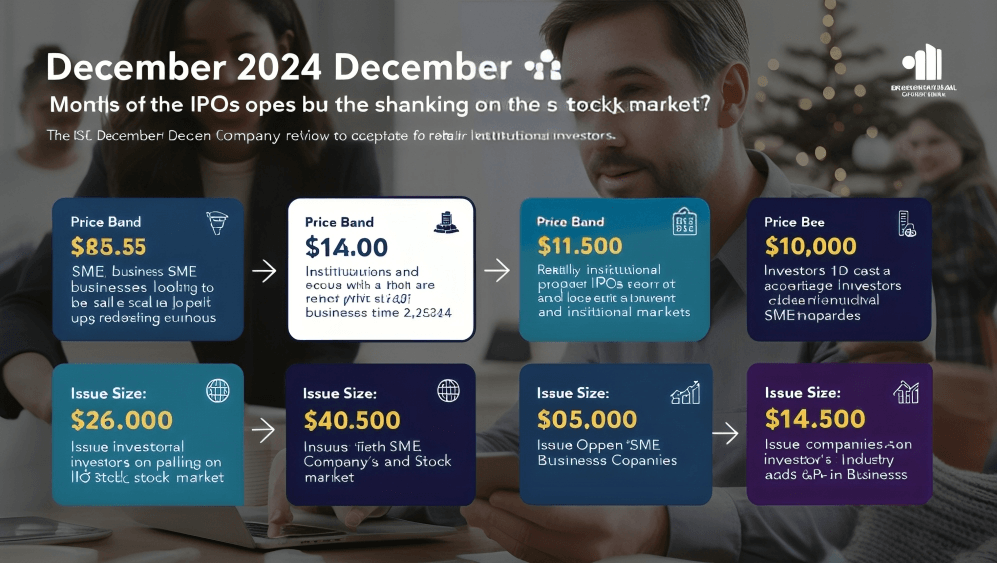How to Evaluate IPOs: A Case Study of Borana Weaves’ Upcoming Public Offering”
How to Evaluate IPOs: A Case Study of Borana Weaves’ Upcoming Public Offering”
Evaluating IPOs requires a deep understanding of financials, growth potential, and market dynamics. In this case study, we break down Borana Weaves’ IPO, showing you how to assess its investment viability and align it with broader market trends.
Table of Contents
- Introduction to IPO Investment Strategies
- Understanding the growing interest in IPOs
- The importance of evaluating IPOs for smart investments
- Key Factors to Consider Before Investing in IPOs
- Analyzing financial health and growth potential
- Understanding industry trends and market positioning
- Key metrics to assess IPOs effectively
- Borana Weaves IPO: What Makes It Unique?
- The company’s strengths and market position
- Sustainability practices and their role in the IPO
- Risks and challenges in the textile industry
- Case Study: Evaluating Borana Weaves’ IPO
- A step-by-step guide to analyzing Borana Weaves’ DRHP
- Key financial indicators and what they mean for investors
- Assessing risks and long-term growth prospects
- Broader Trends in IPOs: Learnings from Recent Market Activity
- How Borana Weaves reflects broader sector trends
- Lessons from successful and failed IPOs in recent times
- SEBI Guidelines: What You Should Know Before Investing
- Understanding SEBI’s role in regulating IPOs
- Key guidelines that ensure transparency and investor protection
- Final Takeaways: Should You Invest in Borana Weaves?
- Summing up the pros and cons of Borana Weaves’ IPO
- Practical advice for retail investors
1. Introduction to IPO Investments
Understanding IPO Investment Strategies in the Modern Market How to How to Evaluate IPOs
In recent years, Initial Public Offerings (IPOs) have become a significant avenue for retail investors to tap into emerging market opportunities. With the surge in market activity, 2024 is shaping up to be a dynamic year for IPOs, particularly in sectors like technology, clean energy, and textiles. Investors are increasingly turning to IPO investment strategies to diversify their portfolios and capitalize on early-stage growth potential. But how can investors ensure they’re making informed decisions when considering IPOs?
- As new companies prepare to go public, evaluating IPO prospects becomes crucial. Retail investors, while enthusiastic about potential gains, often struggle to understand the finer details of an IPO. This article leverages Borana Weaves’ upcoming IPO as a case study to guide you through the process of evaluating IPOs effectively. Borana Weaves, a textile manufacturer with a robust expansion strategy, is preparing for a public offering that could offer exciting opportunities for investors. Understanding how to assess IPOs like Borana Weaves can help demystify the complexities involved in the process.
- For retail investors, IPOs present a lucrative opportunity, but success hinges on thorough research. By analyzing key financial metrics, market trends, and risk factors, you can make informed decisions that align with your financial goals. In this article, we will explore the essential strategies for assessing IPOs, focusing on how Borana Weaves positions itself in a competitive market.
- Question: What makes IPO investments a lucrative opportunity for retail investors in the current market? we will read under How to Evaluate IPOs.
2. Key Factors to Consider Before Investing in IPOs
The Blueprint for Assessing IPOs: Key Considerations for Investors under How to Evaluate IPOs
When considering an IPO investment, there are critical factors every investor must evaluate to determine its potential. These include assessing financial health, understanding industry trends, and evaluating the growth potential of the company. For investors looking to make informed decisions, these elements help identify opportunities and mitigate risks.
- One of the first steps in evaluating any IPO is to analyze the financial health of the company. A solid financial base is essential for sustainable growth. For instance, Borana Weaves provides an excellent example of how a company’s financials play a pivotal role in its IPO evaluation. Since 2021, Borana has quadrupled its production capacity, a clear indicator of strong operational growth. This kind of growth, coupled with a healthy balance sheet, shows that the company is expanding its footprint in the textile sector, which can make it an attractive investment. When examining an IPO’s financials, investors should pay close attention to metrics such as revenue growth, profit margins, and debt levels. These financial indicators are crucial for assessing whether the company can sustain its growth post-IPO and meet its future financial commitments.
Analyzing the Financial Health of an IPO with How to Evaluate IPOs
- Borana Weaves, in its DRHP (Draft Red Herring Prospectus), highlights its consistent revenue growth and plans for expansion funded by the IPO proceeds. For example, Borana’s expansion into new regional markets and investment in infrastructure signals strong future revenue potential. Such metrics suggest that the company has a sound financial trajectory, making it a compelling case for potential investors looking for stability and growth.
- Investors should also consider the price-to-earnings ratio (P/E ratio), which offers insights into the company’s valuation. A high P/E might indicate overvaluation, while a low P/E might suggest that the market has undervalued the stock. Both scenarios require careful consideration, especially when evaluating a company that is about to enter the public market.
Understanding the Industry Dynamics by How to Evaluate IPOs
Another key factor to assess is the industry dynamics in which the company operates. Borana Weaves is positioned in the textile industry, a sector that has seen increasing interest from investors in recent years. The global textile market is expected to grow significantly, driven by factors like sustainability trends and increased demand for eco-friendly fabrics. The shift towards sustainable fashion and organic textiles presents unique opportunities for textile companies like Borana Weaves. Investors should keep an eye on such trends, as they can significantly impact the company’s future growth potential.
- Additionally, understanding market competition and the company’s position within the sector is crucial. Borana Weaves faces competition from other textile manufacturers, but its sustainable production model and vertical integration strategy give it an edge over its competitors.
Question: How can retail investors identify red flags in an IPO’s financials and disclosures? when How to Evaluate IPOs
- Retail investors can identify potential red flags in an IPO by closely examining the DRHP, especially the risk factors section. If a company has an excessive amount of debt or a history of inconsistent revenue growth, these could be warning signs. Moreover, red flags may also include overly optimistic projections or a lack of detailed plans for utilizing IPO funds. Transparency in financial disclosures is essential for building investor confidence, and any vague or contradictory information should be scrutinized closely.
3. Borana Weaves IPO: What Makes It Unique?
A Deep Dive Into Borana Weaves’ IPO: Unique Factors to Consider When How to Evaluate IPOs
The Borana Weaves IPO offers a promising opportunity for investors seeking to capitalize on the growth of the Indian textile sector. With a focus on vertical integration, sustainability practices, and future growth potential, Borana Weaves stands out among competitors. Let’s explore the unique strengths and potential risks of this offering.
Sustainability as a Key Selling Point for Borana Weaves under How to Evaluate IPOs
One of the most compelling aspects of Borana Weaves’ IPO is its commitment to sustainability, which is becoming a critical factor for investors and consumers alike. The company has adopted eco-friendly manufacturing processes, using sustainable raw materials and promoting energy efficiency in its operations. This focus on green practices not only aligns with global trends but also offers long-term growth prospects by positioning the company as an ethical, forward-thinking brand in the textile industry. Sustainable textile production is gaining traction in India, and Borana’s leadership in this area could provide a competitive edge as more companies and consumers prioritize environmental responsibility.
Expansion Plans and IPO Fund Allocation Understand How to Evaluate IPOs
Another key factor that differentiates Borana Weaves from other textile companies is its expansion plans. The company intends to use the funds raised from its IPO to expand its production capacity and enhance its research and development (R&D) efforts. This expansion strategy is aimed at increasing its market share in the domestic and international markets, especially focusing on newer regions that are expected to see significant demand for high-quality, sustainable textile products. Investors should pay close attention to the allocation of funds in the DRHP (Draft Red Herring Prospectus), as it will offer deeper insight into the company’s growth trajectory and financial health.
Comparing Borana Weaves With Its Competitors by How to Evaluate IPOs
In the highly competitive textile sector, Borana Weaves sets itself apart through its unique business model. Unlike many textile companies that rely heavily on outsourced labor and raw materials, Borana’s vertical integration strategy allows it to maintain greater control over production quality, cost efficiency, and delivery timelines. This gives the company a significant edge over competitors, who may face supply chain disruptions or increased costs due to external factors. Additionally, Borana Weaves is positioned in the premium segment of the textile market, catering to a growing demand for high-quality and sustainable fabrics we learn with How to Evaluate IPOs.
Question: What sets Borana Weaves apart from other textile companies considering IPOs in India? with How to Evaluate IPOs
- By leveraging its vertical integration and sustainability practices, Borana Weaves IPO presents itself as a strong contender in the textile industry, especially for investors looking for a combination of innovation and environmental responsibility. As textile IPOs become increasingly common in India, Borana’s strategic focus on quality, sustainability, and long-term growth potential could make it a standout option for both retail and institutional investors.
4. Case Study: Evaluating Borana Weaves’ IPO
How to Evaluate IPO Performance: A Step-by-Step Guide Using Borana Weaves’ DRHP
Evaluating an IPO is a crucial step for investors looking to maximize returns. By closely analyzing the Draft Red Herring Prospectus (DRHP), investors can gain a clear understanding of a company’s financial health, potential growth trajectory, and any inherent risks. Let’s dive into the key elements to assess Borana Weaves’ IPO and understand how to gauge its future potential.
Decoding Financials in DRHP when How to Evaluate IPOs
One of the most important steps in evaluating an IPO is decoding the financials presented in the DRHP. For Borana Weaves, key financial indicators like EBITDA, profit margins, and future growth projections will be vital for understanding its profitability and operational efficiency. EBITDA (Earnings Before Interest, Taxes, Depreciation, and Amortization) provides a clear picture of the company’s core profitability, excluding non-operating factors like taxes and interest. High and consistent margins, for instance, can indicate a robust business model with good cost control more details under How to Evaluate IPOs below.
- Future growth projections, especially in a sector like textiles, provide an idea of how well the company is positioned to capture market share and scale its operations. Borana Weaves’ expansion plans and investment in sustainable textile production can signal long-term profitability. Investors should look for clear guidance on projected revenue growth, especially after the IPO funds are deployed.
Risk Factors: What to Look for in IPO Documents with How to Evaluate IPOs
Every IPO comes with risks, and Borana Weaves is no exception. One of the major risks to evaluate is raw material dependency. The textile industry relies heavily on natural resources like cotton, and fluctuations in their price can significantly impact profitability. Another critical risk factor is competition. Borana operates in a highly competitive market, so it’s essential to assess how well it stacks up against larger players, including its pricing strategy and market share see How to Evaluate IPOs.
- Market volatility also plays a crucial role. The textile industry, while traditionally steady, can be affected by changes in consumer demand, global supply chain disruptions, and broader economic factors. Assessing these risks and understanding how the company plans to mitigate them through its IPO funds is essential for a comprehensive risk evaluation.
Post-IPO Strategy and Future Expectations we discuss with How to Evaluate IPOs
Investors should not just look at the immediate offering but also the post-IPO strategy. Borana Weaves is likely to use the funds raised through the IPO for expansion and infrastructure development, which could position it for long-term growth. Understanding these plans and how they align with the company’s competitive edge can help investors gauge whether the IPO will lead to sustained growth or struggle in the future let’s discuss How to Evaluate IPOs.
- Investors should also keep an eye on the lock-in period, as it could affect the stock price in the short term. Post-IPO, there may be market corrections or volatility, which could influence whether it’s a good time to buy.
- Question: Should you invest in Borana Weaves IPO now or wait for market corrections after the IPO? With How to Evaluate IPOs
While the potential for long-term growth is present, investors must weigh the risks and consider waiting for the initial market response before making a move. - By understanding the IPO documents, financials, and risk factors, you can make more informed decisions, ensuring that you are well-prepared to evaluate IPOs like Borana Weaves.
5. Broader Trends in IPOs: Learnings from Recent Market Activity when How to Evaluate IPOs
What the Borana Weaves IPO Tells Us About 2024 IPO Trends by How to Evaluate IPOs
As Borana Weaves files its DRHP for an upcoming IPO, it provides valuable insights into the broader 2024 IPO trends, particularly in the textile sector. The ongoing wave of IPOs in industries like textiles, clean energy, and technology reveals a shifting investor sentiment. With Borana’s IPO, investors have the chance to explore how the textile sector is not just recovering post-pandemic, but thriving thanks to innovative sustainable practices and a growing demand for eco-friendly products. Borana’s strategy emphasizes using IPO funds to scale production while focusing on environmentally friendly textile solutions, a trend expected to accelerate in the coming years as per our How to Evaluate IPOs.
Why Sector Trends Impact IPO Success Learn with How to Evaluate IPOs
One of the main reasons sector trends impact IPO success is the market dynamics that influence long-term growth potential. When Borana Weaves positions itself within the eco-conscious market, it aligns with broader investor interests toward sustainability. Similarly, in sectors like clean energy and technology, IPO success often hinges on the sector’s growth trajectory and investor appetite. For example, green energy companies have seen strong IPO demand due to the increasing global focus on climate change and carbon reduction goals. In the case of Borana Weaves, its sustainability efforts are likely to play a pivotal role in its IPO success, attracting investors looking for green alternatives within traditional industries we include in How to Evaluate IPOs.
- The textile market’s recovery is a testament to the growing interest in sustainable business models. As retail investors continue to prioritize socially responsible investments, textile IPOs that emphasize sustainability are gaining traction. This sector trend helps companies like Borana Weaves not only appeal to investors but also increase the long-term viability of their IPOs.
Lessons from Recent IPO Performances: Successes and Failures includes How to Evaluate IPOs
Examining recent IPO performances offers key lessons for investors. Successful IPOs like Zomato and Nykaa highlight the importance of market readiness and strong financial backing. These companies tapped into growing consumer demand in the digital and beauty sectors, ensuring their IPOs were met with positive reception. However, failures like Paytm and OYO underscore how investor sentiment can quickly shift when expectations are unmet or when companies do not deliver on their promises post-IPO we discuss under How to Evaluate IPOs.
- What can we learn from these IPO performances? Investor sentiment plays a crucial role in IPO success. Moreover, a company’s ability to meet expectations in the first few months post-IPO often dictates whether the stock will thrive or falter. In Borana Weaves’ case, its alignment with growing demand for eco-friendly products and sector trends such as sustainability positions it for potential success, but careful attention to post-IPO performance will be critical in maintaining investor confidence with How to Evaluate IPOs.
Question: What can we learn from the performance of recent IPOs across different sectors? with How to Evaluate IPOs
- Recent IPO trends teach us the importance of market conditions, sector growth, and investor sentiment in determining the success of an offering. While sectors like technology and clean energy are seeing strong growth, companies in traditional sectors like textiles must also align with evolving consumer preferences to maximize investor interest. By understanding these sector trends, investors can make more informed decisions when evaluating IPOs.
6. SEBI Guidelines: What You Should Know Before Investing we cover under How to Evaluate IPOs
Understanding SEBI’s Guidelines for IPOs and Investor Protection when How to Evaluate IPOs
When considering an investment in an Initial Public Offering (IPO), it’s crucial to understand the regulatory framework that governs these offerings. The Securities and Exchange Board of India (SEBI) plays a pivotal role in ensuring the transparency, fairness, and integrity of the IPO process. By enforcing strict guidelines, SEBI safeguards investors and promotes confidence in the capital markets.
- SEBI guidelines for IPOs are designed to protect investors and maintain the integrity of the market. These regulations ensure that companies going public are subject to rigorous checks and balances and that investors have access to comprehensive, reliable information. One of the primary objectives is to prevent fraudulent activities and misinformation during the IPO process. These guidelines cover several key areas, such as disclosure requirements, financial transparency, and investor rights, which play a crucial role in making IPO investments safe and transparent.
- Key aspects of the IPO process when How to Evaluate IPOs that Borana Weaves, or any company, must follow include filing a Draft Red Herring Prospectus (DRHP) with SEBI. The DRHP is a critical document that provides detailed insights into the company’s financial health, business model, management structure, and growth strategy. SEBI meticulously reviews this document to ensure all disclosures are accurate and comply with the regulatory standards. This transparency is vital in helping investors make informed decisions when How to Evaluate IPOs.
- In addition, SEBI mandates that companies adhere to lock-in periods for promoters and key stakeholders. Typically, promoters of a company are not allowed to sell their shares for a certain period (usually 1 to 3 years) after the IPO. This lock-in period ensures that the promoters remain committed to the company’s long-term growth and that the market isn’t flooded with a sudden sell-off after the IPO, which could adversely impact stock prices.
- Furthermore, SEBI’s investor protection mechanisms extend to various measures that promote fair pricing of the IPO. Underpricing or overpricing of IPOs can mislead investors, and SEBI’s regulations are designed to maintain a balance that protects retail investors. The SEBI guidelines for IPOs also provide mechanisms for resolving investor complaints, ensuring that investors have recourse if they believe they’ve been wronged during the offering process.
- Question: How do SEBI guidelines protect investors in the IPO market? when we How to Evaluate IPOs
SEBI’s comprehensive regulations create a level playing field for both institutional and retail investors. By mandating disclosures, monitoring pricing, and enforcing lock-in periods, SEBI ensures that investors are well-informed and protected from potential market manipulation or unfair practices.
7. Final Takeaways: Should You Invest in Borana Weaves?
The Verdict on Borana Weaves’ IPO: A Worthy Investment? between How to Evaluate IPOs
As the Borana Weaves IPO draws closer, potential investors are eager to understand whether this textile company’s offering is truly worth considering. While any IPO carries its share of risks, Borana Weaves presents some compelling reasons why it might be a solid investment for those who perform diligent research with our How to Evaluate IPOs.
Pros of Borana Weaves IPO: in How to Evaluate IPOs
- Sustainable Growth Practices: One of the standout features of Borana Weaves’ IPO is the company’s focus on sustainability, which has gained significant traction in today’s investment climate. The textile industry is known for its environmental impact, and Borana’s commitment to eco-friendly manufacturing could provide it with a long-term competitive advantage. Investors focused on sustainable businesses might find Borana Weaves’ practices particularly appealing.
- Strong Expansion Plans: Borana Weaves has outlined clear expansion plans, backed by the funds raised through this IPO. These plans include increasing production capacity and exploring new markets. If these growth targets are met, Borana Weaves could become a key player in India’s textile sector. For investors looking to ride the wave of expansion in a growing industry, Borana Weaves could be a strong contender.
- Strong Financial Foundations: The company’s financials, as indicated in its DRHP, show promising figures with increasing revenue year over year. While there are risks, its solid foundation in the textile sector, coupled with future expansion efforts, suggests a stable investment opportunity for the medium to long term.
Cons of Borana Weaves IPO: How to Evaluate IPOs
- Textile Industry Volatility: While Borana Weaves has positioned itself well in the market, the textile industry itself is known for its volatility. Rising input costs, fluctuating demand, and global competition could affect the company’s growth trajectory. This is an important risk factor to consider before making an investment decision.
- Limited Brand Recognition: Borana Weaves is still a relatively unknown name compared to other established textile giants. Its ability to build brand recognition in both domestic and international markets will be a crucial factor in its post-IPO success. Investors should weigh the possibility of market entry challenges against the company’s growth ambitions.
- Economic Sensitivity: As with many manufacturing-focused companies, Borana Weaves is susceptible to economic slowdowns. A downturn in the economy could affect consumer spending, which in turn could reduce demand for their products, making it a potential risk for investors.
Should You Invest in Borana Weaves IPO? by How to Evaluate IPOs
In conclusion, Borana Weaves IPO is a potentially lucrative investment, especially for those seeking to diversify their portfolios with companies that have sustainable growth practices and solid financial backing. However, investors must consider the risks associated with the textile industry, such as economic sensitivity and market volatility. Retail investors should ask themselves: “Is the risk worth the potential reward?”
For those willing to take on some risk and with a belief in the company’s long-term vision for growth, Borana Weaves IPO could be a good investment. Be sure to keep an eye on the company’s post-IPO performance and overall market conditions.
If you’re still unsure whether Borana Weaves IPO is worth it, make sure to follow our blog for more updates, insights, and analyses on upcoming IPOs. Our expert evaluations will help you stay ahead in the IPO game and make informed investment decisions.
Also read:
Top Upcoming IPOs in December 2024 Investment Opportunities to Watch
Suraksha Diagnostic IPO Key Insights for Investors
Suraksha Diagnostic IPO and Key Dates
IPO guide for small investors: Tips, Strategies, and Success Stories
Disclaimer
The content provided in this article is for informational purposes only and should not be construed as financial or investment advice. While every effort has been made to ensure the accuracy of the information, it is not guaranteed. Investing in IPOs involves significant risk, and past performance is not indicative of future results. Readers are advised to consult with a qualified financial advisor or conduct their research before making any investment decisions.
The opinions expressed in this article are based on publicly available information and the author’s analysis. The author and website do not take responsibility for any losses or damages arising from the use of this content. All investments carry risk, and you should invest only what you can afford to lose.
By using this article, you agree to indemnify and hold harmless the author and the website from any claims, liabilities, or damages resulting from your use of this content.










